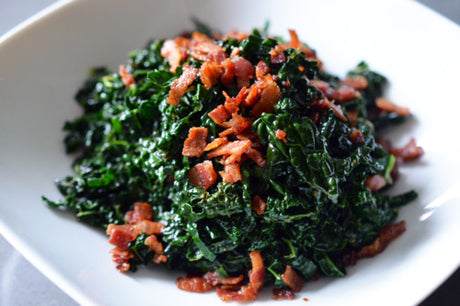Table of Contents:
You're standing in the supermarket wondering: is a tomato a fruit or a vegetable? You're not the only one who has this doubt. The difference between a fruit and a vegetable seems simple, but in reality, it all depends on your perspective.
The confusion arises because different disciplines have their own definitions. What botanically is considered a fruit, we often use in the kitchen as a vegetable. And that makes it all a lot more complicated than you might think.
In this article, we'll guide you through the various definitions and offer practical tips that will really help you. So you'll know for sure how to get your daily serving of fruits and vegetables.
The main points of the eternal dilemma
- Botanically speaking, tomatoes, peppers and cucumbers are fruits, but in the kitchen we use them as vegetables
- The daily recommendation is 250 grams of vegetables and 200 grams of fruit for optimal health
- The classification depends on the perspective: botanical, culinary, horticultural or nutritional
- For practical use: eat vegetables with the main meal, fruit as a snack or dessert.
- Variety is more important for your health than perfect classification

What is the Difference Between Fruits and Vegetables?
The distinction between fruits and vegetables is less clear-cut than most people think. Depending on who you ask, you'll get a very different answer.
Botanical definition: From a botanical perspective, a fruit is anything that develops from a fertilized flower and contains seeds. Vegetables are all other edible parts of plants—such as roots, leaves, stems, and flowers. This means that tomatoes, peppers, and cucumbers are botanically considered berries!
Culinary definition: In the kitchen, we primarily focus on taste and use. Vegetables are usually prepared hot with main meals and have a savory or neutral flavor. Fruit is often eaten raw as a snack or dessert and usually tastes sweet or sour.
Horticultural definition: Here we distinguish based on the plant itself. Everything that grows on herbaceous plants is considered a vegetable, while fruit comes from woody plants like trees and shrubs.
For everyday use, the culinary classification is most practical. If you eat a tomato with your hot meal, it counts as a vegetable towards your daily 250 grams. The fruit per day – the recommended 200 grams – is mainly apples, pears, and bananas, which you eat as a snack.
Different Perspectives on Classification
The reason there's so much confusion lies in the fact that each discipline has developed its own criteria. These differences haven't arisen to confuse us, but because each field has different goals.
According to Van Dale, vegetables are defined as "plants used as food," while fruits are "edible fruits of plants." So, it's very general, and that leaves plenty of room for interpretation.
Botanical Classification
Botanically, it's purely about how the plant develops. Fruits always develop from the ovary of a flower and contain the plant's seeds. This explains why tomatoes, peppers, cucumbers, and zucchini are all botanically berries.
Vegetables therefore include all other edible plant parts:
- Roots such as carrots and radishes
- Leaves such as lettuce and spinach
- Stalks such as celery and asparagus
- Flowers such as cauliflower and broccoli
It is a very logical classification from a botanical perspective, but one that often clashes with how we use these products in practice.
Horticultural Layout
Horticulture takes a different approach. Here, we look at the plant on which the product grows. Herbaceous plants—which are usually annuals and lack a true woody stem—produce vegetables. Woody plants such as trees and shrubs produce fruit.
This classification works well for most cases, but it also has its exceptions. Strawberries, for example, grow on herbaceous plants but are still considered fruits. Bananas come from a type of tree but have little actual wood in their trunks.
Melons are classified as vegetables in horticulture because they grow on herbaceous plants, although we often use them as fruits in culinary terms.

Well-Known Examples of Confusion
Some products repeatedly cause headaches. These well-known examples perfectly illustrate why different definitions can lead to different classifications.
The tomato is probably the most well-known example. Botanically, it's clearly a fruit—it develops from a flower and contains seeds. But in culinary terms, we primarily use tomatoes in savory dishes, soups, and sauces. This confusion was even legally resolved in the United States. In 1893, the Supreme Court ruled in Nix v. Hedden that tomatoes should be considered vegetables for tax purposes because people used them that way.
Rhubarb is the opposite story. Botanically, it's a vegetable stalk, but in the kitchen, it's mainly used in pies, jams, and other desserts. Therefore, we consider rhubarb a fruit in culinary terms, even though it's technically a vegetable.
Strawberries aren't berries at all, botanically speaking, but false fruits. The real fruits are the small seeds on the outside. Yet, we call them fruit and treat them as such in the kitchen.
Avocado is botanically a fruit, but it's increasingly used as a vegetable in salads and savory dishes. Its neutral flavor and creamy texture make it a better match for vegetables than fruit.
Nutritional Value and Health Aspects
The botanical classification actually matters less for your health than you might think. It's much more important that you get enough variety from both categories every day.
Fruit does, on average, contain more natural sugars than most vegetables. An apple, for example, contains 11.8 grams of sugar per 100 grams, while broccoli contains only 1.5 grams per 100 grams. This also explains why fruit often tastes sweeter and why we eat it raw more often.
Vegetables are often richer in certain minerals and contain more fiber per calorie. Fruit, on the other hand, is often packed with vitamin C and various antioxidants. Both groups contribute to good health in their own way.
The daily recommendation according to the Wheel of Five is clear: 250 grams of vegetables and 200 grams of fruit per day. This recommendation is based on extensive research into what our bodies need to function optimally. This refers to the culinary classification—so tomatoes eaten with your hot meal count as vegetables.
Nutrition experts say variety is much more important than perfect classification. No single type of fruit or vegetable contains all the nutrients you need. Therefore, variation in color, flavor, and preparation methods is key to a healthy diet.

Practical Tips for Daily Use
Now that you know how the different definitions work, it's time to put them into practice. How do you ensure you get enough fruits and vegetables every day?
Vegetables at every meal: Start your day with a tomato or cucumber on your sandwich. Add bell peppers, lettuce, or other vegetables to your lunch. And make sure half of your dinner consists of vegetables. This way, you'll easily reach your 250 grams per day.
Fruit as a snack: Have a piece of fruit twice a day. An apple after lunch, a banana in the afternoon, or a handful of berries with your yogurt. This way, you'll easily reach your 200 grams of fruit per day.
Make seasonal choices: Whenever possible, choose seasonal fruits and vegetables from your region. This not only tastes better, but is also more sustainable and often cheaper. In winter, for example, this means winter vegetables like Brussels sprouts and chicory; in summer, you'll be short on fresh lettuce and tomatoes.
The "My Food Meter" app can help you track how much fruit and vegetables you eat. It's very useful for getting a feel for the right amounts in the beginning.
Easy Recognition in Practice
For daily use you can use these rules of thumb:
Hot preparation versus raw consumption: Vegetables are usually boiled, steamed, or baked before consumption. Fruit is usually eaten raw, with a few exceptions such as stewed pears.
Placement in the meal: Vegetables are part of the main course, while fruit is often served as a dessert or snack. This classification usually follows the culinary classification.
Flavor profile: Vegetables taste savory, bitter, or neutral. Fruits usually taste sweet or sour. There are exceptions, such as avocado (a neutral but botanical fruit) and rhubarb (a sour but botanical vegetable).
Store layout: Most supermarkets follow the culinary classification system. Tomatoes, peppers, and cucumbers are found with the vegetables, even though they are considered fruits.

Frequently Asked Questions
Is a tomato a vegetable or a fruit?
Botanically speaking, a tomato is a fruit because it develops from a flower and contains seeds. However, in cooking, the tomato is used as a vegetable because of its savory flavor and use in main courses. For nutritional advice, a tomato counts as a vegetable in the 250-gram daily recommendation. In practice, it doesn't matter how you classify it for your health, as long as you eat enough variety.
Why are there so many different definitions?
Each discipline has developed its own criteria for its specific purposes. Botany considers botanical properties for scientific purposes, cuisine considers taste and culinary uses, and horticulture considers growing conditions. These definitions originated historically for various practical purposes, such as taxation, crop planning, and nutritional information.
How do I count my daily fruits and vegetables?
Use the culinary classification for convenience: vegetables you eat with main meals count as vegetables. Fruit eaten as a snack or dessert counts as fruit. 250 grams of vegetables corresponds to about 2-3 large servings of vegetables spread throughout the day. 200 grams of fruit is about 2 medium-sized pieces of fruit, such as an apple and a pear.
Are there any more confusing examples?
Absolutely! Rhubarb is used as a fruit in pies, but botanically it's a vegetable stalk. Nuts are botanically fruits but are classified separately because of their high fat content. Snow peas and peas are actually seeds but are considered vegetables. Mushrooms aren't plants at all, but fungi, yet we consider them vegetables. These exceptions make the topic so interesting!
Does it make a difference to my health?
For your health, the exact classification is much less important than sufficient variety and reaching the recommended amounts. Whether you count tomatoes as a fruit or a vegetable, they provide the same nutrients. Therefore, focus on eating a wide variety of colors, flavors, and textures. Both botanical fruits used as vegetables (such as tomatoes) and actual fruit contribute to a healthy diet.













